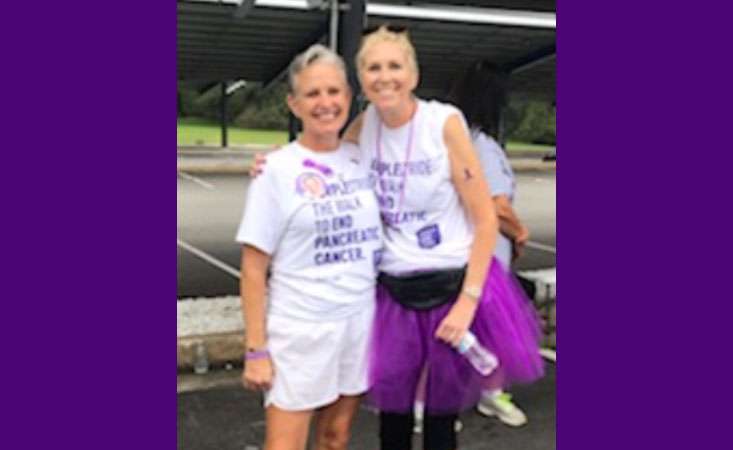
As I approach my fifth year of pancreatic cancer survivorship, I have come across a certain, or maybe an uncertain, place of acceptance – an unfair acceptance that I have survived and many other patients have not. Through this revelation, I have found a voice where I can be an advocate for pancreatic cancer research.
I have found myself sitting on some sort of “timeline,” one that represents the urgency and importance for the immense need in pancreatic cancer research.
In January 2010, my sister passed from this terrible disease. She was 42 years old, leaving behind her husband, young son and daughter along with many family and friends who loved her dearly. Our family had recently learned several of us carry the mutated BRCA2 gene. Cancer was a common word in our family, and therefore we followed through on preventive measures and early diagnostic screenings. We had not faced pancreatic cancer previously and soon discovered the battle we were facing as a family. My sister was diagnosed at stage IV and had limited treatment options available to her. She bravely underwent treatment, never losing hope in a seemingly hopeless situation. She fought the fight for 20 months. We knew then, more help was needed in this fight against pancreatic cancer.
After my sister’s death, my family members and I continued with regular screenings for breast, melanoma and pancreatic cancer. My brother added prostate screening. As research suggested, I had an oophorectomy to prevent ovarian cancer and help guard against breast cancer.
January 2015, I was diagnosed with stage I breast cancer (BRCA2-related). I proceeded with chemotherapy, mastectomy and preventive mastectomy. A sigh of relief post-treatment and surgery. Back to “regular” screening. November 2015, an annual routine endoscopic ultrasound (EUS) revealed a very tiny “something” on my pancreas. My amazing doctor really was not concerned but, to err on the side of caution, had me return three months later for a follow-up EUS. February 2016, I was diagnosed with stage II pancreatic cancer.
My sister is my hero. Through her journey, I became educated in the importance of screening for the detection of early pancreatic cancer in the BRCA2 patient. But, maybe even more important, is how research has led to more treatment options for the BRCA2 patient since the time of her diagnosis.
My survival was first addressed by earlier detection through diagnosis with an endoscopic ultrasound. Secondly, finding it early enabled me to have surgery and analysis of my tumor through PanCAN’s Know Your Tumor® precision medicine service. Thirdly, my pancreatic cancer was treated with a special chemotherapy mix, including platinum chemotherapy. Research has shown that platinum chemotherapy is an effective agent for the BRCA2 pancreatic cancer patient. My sister was not offered this line of treatment, as it was not available at that time. Fourthly, I was also treated with a PARP inhibitor targeted therapy, which is now a proven weapon against BRCA2 pancreatic cancer. My sister was not offered this, as research had not yet proven it.
My survival is the result of research applied.
As I travel on this “timeline,” I was introduced to a new very dear friend while I was receiving treatment for pancreatic cancer. She and I both had been fighting two primary cancers (breast and pancreatic) at very close time and age intervals. Our initial staging was similar also. We enjoyed many walks with our pups and lunches over bagels. We had a unique friendship that created hope, encouragement and inspiration. I continued to get well and thrive due to my course of treatment that research had proven to improve outcome for the BRCA2 pancreatic cancer patient. My dear friend did not have a BRCA mutation, and her options were limited. She fought, kept hope and was truly an inspiration, but her treatment options had not progressed as much as the BRCA pancreatic cancer patient’s had, and she lost her battle with this deadly disease.
This “timeline” does not end here. We must continue to wage war against this deadly cancer. Through funding, we can keep research and clinical trials thriving so all pancreatic cancer patients can have hope, not only to battle this cancer but to be cured and able to live and thrive.
Throughout this 13-year “timeline,” the Pancreatic Cancer Action Network has been vital to all of our care. They attack pancreatic cancer on all fronts: research, clinical initiatives, patient services and advocacy. Their goal is to improve patient outcomes with the right team, right tests and right treatment. Our family and friends have been participating in PanCAN’s PurpleStride walk/run for 13 years. It has been rewarding joining together and being proactive in fundraising and advocacy. We have joined forces together using our stories and voices as we take to Capitol Hill on PanCAN’s National Advocacy Day.
Let us keep waging hope together so as this “timeline” advances from the past, present and into tomorrow, all of our friends and family will have continued hope and much better outcomes, surviving and thriving with pancreatic cancer.
Editor’s note: Every pancreatic cancer patient is different. Patients who receive treatment based on their biology can live longer. PanCAN strongly recommends all pancreatic cancer patients get genetic testing for inherited mutations as soon as possible after diagnosis and biomarker testing of their tumor tissue to help determine the best treatment options.
Any treatments, including clinical trials, mentioned in this story may not be appropriate or available for all patients. Doctors take many things into account when prescribing treatments including the stage and type of cancer and the overall health of the patient.
















